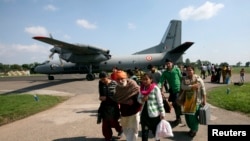Rescue workers from Pakistan and India are rushing to reach thousands of people marooned by heavy monsoon rains and flash floods, which already have killed more than 400 in the two countries.
Pakistani and Indian troops have used boats and helicopters to evacuate victims and to leave food supplies for stranded families. Officials say about 200 people in India and at least 205 in Pakistan have died.
The floods have put about 500,000 people in peril and left thousands homeless. They also have caused major losses on both sides of the divided Kashmir region, where entire villages, military bases and hospitals have been submerged.
Areas in Punjab province in northern and eastern Pakistan have experienced much devastation. On the Indian side of the heavily militarized de facto border that divides the Himalayan region, more than 2,000 villages and the city of Srinagar were submerged.
Rapid response needed
Indian politicians are calling for quick action by the government.
Manish Tewari, leader of India's opposition Congress Party, said, "The situation is extremely grave." He urged the central government to cooperate fully with state officials to ensure that "relief and rescue operations are carried out in a seamless manner."
“The damage is shocking, people have been stranded on rooftops of their homes for the last three days in some parts of Kashmir,” a senior official of the National Disaster Response Force said in New Delhi.
The official, who requested anonymity, said he would have deployed disaster response teams in Kashmir before the floods if his office had been given accurate weather predictions.
“We were all caught off guard because there was not a single warning issued by the weather office. The flash floods took us by surprise,” he said.
No warning
India's metrological department forecast heavy rains in Kashmir last week, but the Central Water Commission, which issues flood advisories, has been criticized by Indian media for not warning the state.
The flooding is the first major humanitarian emergency under new Indian Prime Minister Narendra Modi, who called it a “national disaster.” It comes at a difficult time for Pakistani Prime Minister Nawaz Sharif, who has faced weeks of street protests aimed at forcing his resignation.
India has hundreds of thousands of soldiers stationed in Kashmir, manning the border and conducting counter-insurgency operations against separatist militants in a decades-old conflict that claimed thousands of lives at its peak but has cooled off in recent years.
“Fortunately it is not raining in Kashmir today and we are now getting a chance to send our teams across the region to help tens of thousands of people who have been displaced,” Indian defense ministry spokesman Sitanshu Kar said.
Pakistan plan
In Pakistan, 203 people were reported killed by the flash floods in Kashmir and other northern areas of the country.
Saeed Qureshi, an official at the State Disaster Management Authority [SDMA], said the volume of rainfall had rendered contingency plans useless.
“Nobody can fight with nature,” said Qureshi. “We had made a contingency plan, identifying vulnerable populations along the banks of rivers and torrents, but rains with unexpected density wreaked havoc on the hilly areas beyond our imaginations.”
“The amount of rainfall in a day was a staggering; 400 millimeters in Haveli which had no parallel in the past 50 years,” he said, adding that his organization was badly in need of more resources.
The International Federation of Red Cross and Red Crescent Societies said this year's monsoon rains have killed more than 1,000 people in India alone.
When flash floods two years ago in the Himalayan Indian state of Uttarakhand killed 5,000 people, including many Hindu pilgrims, disaster relief authorities were criticized for their slow response.
Some material for this report came from Reuters.








